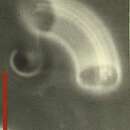Description of Metromonas simplex
provided by BioPedia
Cells are obovate, 3 to 8 microns long (mostly 4 to 7 microns), 2 to 6 microns wide and dorso-ventrally flattened, and have smooth pellicle. The margin of the cell that is away from the flagella is thicker than the (posterior) margin. Two flagella of very unequal length arise from the posterior part of the cell. The major flagellum is always present, is about 1.5 to 3.0 times the length of the cell and may be attached to the substrate. The short inactive flagellum is about 1 microns long and inserts to the right of the major flagellum. It may be difficult to see. The cells normally attach to the substratum and swing from side to side like a pendulum and the cells may also glide with the cell body in front of the flagellum.
Description of Metromonas simplex
provided by BioPedia
Biflagellate, gliding cells 10-25 microns with oval-ovoid flattened bodies and subapically inserted, unequal flagella. Ventral cell side with weakly developed furrow. Nucleus anterior or antero-lateral. Pseudopodia have not been observed. One flagellum, about half as long as the cell body, is anteriorly directed. It beats more to the left side of the cell with a flexible, low amplitude beat. The other flagellum is 1-3 times the length of the body, and trails with the entire flagellum adhering to the substrate. When gliding the anterior tip of the cell is adpressed to the substrate and the posterior end is directed away from it. The cell body wags in unison with the flagellar beat.

